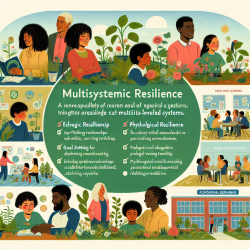In the complex landscape of education and therapy, understanding resilience as a multisystemic process is crucial. The research article "Researching Multisystemic Resilience: A Sample Methodology" by Ungar et al. (2020) provides a comprehensive framework that can be transformative for practitioners aiming to support youth in stressed environments. This blog explores key insights from the research and offers guidance on applying these findings in practice.
Understanding Multisystemic Resilience
Resilience is not just an individual trait but a dynamic process involving biological, psychological, social, and environmental systems. The study conducted by Ungar et al. (2020) highlights the importance of Protective and Promotive Factors and Processes (PPFPs) that operate across these systems. By analyzing data from diverse communities dependent on oil and gas industries, the study illustrates how resilience can be researched and understood through a multisystemic lens.
Key Findings for Practitioners
- Interconnected Systems: Resilience is influenced by interactions within and between multiple systems. Practitioners should consider not only individual coping strategies but also the broader social and ecological contexts that support or hinder resilience.
- Cultural Contexts: The study emphasizes the role of cultural dynamics in shaping resilience. For instance, community support structures may differ significantly across cultures, affecting how resilience manifests.
- Longitudinal Insights: The research utilizes a longitudinal approach to capture changes over time, providing valuable insights into how resilience develops and sustains under stress.
Applying Research Insights
Practitioners can leverage these findings to enhance their support strategies for youth. Here are some practical steps:
- Holistic Assessment: Evaluate not only individual traits but also family dynamics, community resources, and environmental conditions when assessing resilience.
- Culturally Sensitive Interventions: Design interventions that respect cultural values and practices, recognizing their role in promoting resilience.
- Collaborative Approaches: Work with community stakeholders to identify local resources and strengths that can be harnessed to support youth.
The Path Forward
The research by Ungar et al. (2020) provides a robust methodology for understanding resilience in complex environments. By embracing a multisystemic perspective, practitioners can develop more effective interventions that address the diverse needs of youth facing adversity.
To read the original research paper, please follow this link: Researching Multisystemic Resilience: A Sample Methodology.










